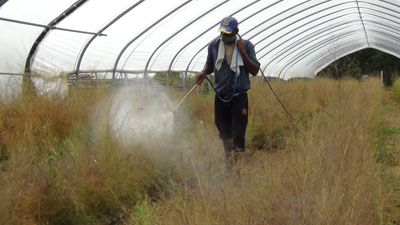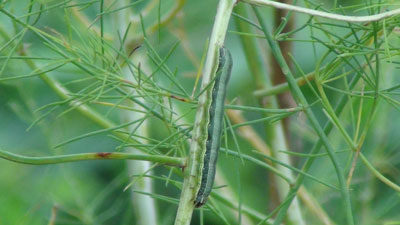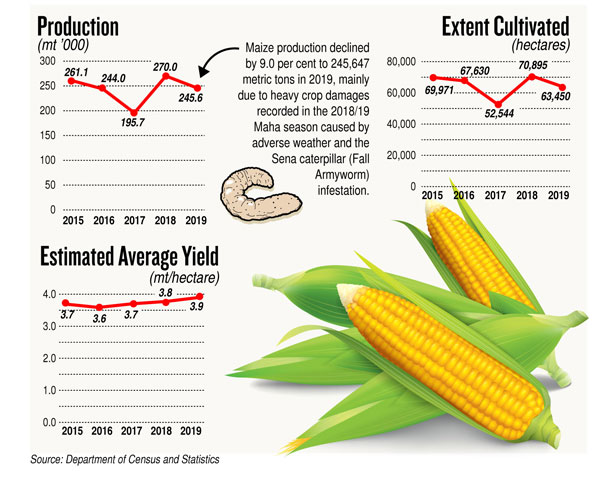News
Fall Armyworm attack: Conflicting claims over damage to maize cultivation
The Agriculture Minister and the Agriculture Department Director General are at variance over the extent of damage caused by the Fall Armyworm (Sena Dalambuwa) which is devastating the maize crop in Sri Lanka.
Agriculture Minister Mahindananda Aluthgamage said the damage was mere three present of the cultivation and it could lead to a loss of about 3,000 Mt of corn. Agriculture Director General W.M.W Weerakoon, however, said about 25 percent of the maize cultivation had been affected.

Spraying a new variety of germicide to get rid of the Fall Armyworm. Pix by Hiran Priyankara
The DG said they were expecting a yield of 40,000 Mt of corn from 101,000 hectares of maize fields across the country before the problem set in.
Both the minister and the DG expressed confidence that by sprinkling ash and spraying a new variety of germicide, the Fall Armyworm threat could be eliminated. This was because the worms found in the farmlands were in their larval stage.
Minister Aluthgamage said that eradicate the Fall Armyworm infestation, field officers were visiting the farmers to distribute the new chemical to . He said the germicide imported by a private company was also available in the market.
The minister said Rs. 6 million had been released to the Uva Provincial Council to carry out the eradication programme and he had also asked the ministry to fund the programme in the Anuradhapura district.
However, farmers associations expressed displeasure over the delayed action by the Agriculture Ministry. They said field officers were visiting only now after much damage had been done to the plants two months before the harvest.
According to them, the worst affected districts are Amapara, Anuradhapura, Polonnaruwa, Krunegala and Monragala.
 All-Island Farmers Federation (AIFF) Secretary T.B. Sarath told the Sunday Times the Agriculture Department was claiming that it had found a solution but by then about 80 percent of maize crops had been destroyed.
All-Island Farmers Federation (AIFF) Secretary T.B. Sarath told the Sunday Times the Agriculture Department was claiming that it had found a solution but by then about 80 percent of maize crops had been destroyed.
“The Government is aware of the Fall Armyworm’s life cycle as the germ had been affecting the crops since 2018. The Government should have found ways to eliminate the pest first before telling us to start cultivation,” he said
Mr. Sarath said thy welcome the Government’s decision to stop corn imports, but the farmers were unable to reap the benefits of the move as nearly 80 percent of the maize cultivation had been destroyed.
He urged the Government to implement a national plan on crop cultivation without just urging farmers to cultivate haphazardly.
Refuting these claims, Minister Aluthgamage said farmers associations were exaggerating the situation. “The Government stopped importing corn to empower the farmer. As a result the corn prices slightly went up, prompting the farmers to cultivate in excess,” he said.
Due to the excess cultivation, there would not be a shortage in the market, the minister said, adding that the ministry had worked out a scheme to pay compensation to the affected farmers.
He also accused some corn importers of creating unnecessary problems as they had been affected by the import ban.
District secretaries said extensive damage had been caused to the crop due to the invasion of the Fall Armyworm.
Anuradhapura District secretary D. Weeraratna told the Sunday times about 20,000 acres of corn cultivation in their area had been affected by the Fall Armyworm.
“This amounts to about 50 percent of crop damage,” he said.

Ampara District secretary D.M.L. Bandaranayake said about 20 percent of the cultivation in the district had been damaged due to the Fall Armyworm attacks.
Maize importer Palaniandi Maheshwaran said Sri Lanka’s annual maize requirement was 450,000 Mt and of this amount only fifty percent was met through domestic production. He explained much of the imported maize was sent to a private company to produce chicken feed while the rest was used production of nutritional supplements such as Samaposha and Thriposha and in the manufacture of biscuits.
Mr Maheshwaran said that even though they were barred from importing corn, he believed a few companies would be allowed to import maize to meet the shortfall created by the Fall Armyworm crisis.

